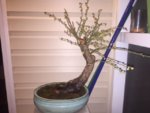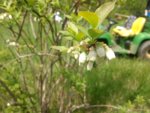SO to re-cap,
My recommended blueberry mix is roughly
40% to 50% pumice
25 to 35 % fir bark, or pine bark or a mix of both, composted for one year is ideal, fresh will work if you can not take the time to compost it)
15% to 25% Canadian peat moss
5 to 10 % hardwood sawdust - this is to feed the endomycorrhiza that blueberry depend on.
Mix then sift. You will loose a lot of the peat, and much of the sawdust when sifting. I pre-sift these two items to keep the percentage up, but the exact percentages are not critical, so you don't have to make this too complicated.
optional
5% horticultural charcoal. - this too seems to help the mycorrhiza.
after mixing and potting up - add:
one tablespoon of elemental sulfur, per ''gallon'' of potting media - I have medium hard water, this is to provide long term slow acidification, & nutrition (sulfur is a macronutrient). Use the coarser grind labelled for soil acidification. It will take about one year to dissolve. Repeat once a year. If you can only get the very fine powder, intended as a fungicide or pesticide - add only one teaspoon per gallon, and repeat the dose once every 4 months. The finer powder dissolves quicker, lasting about 4 months.
Note, I grow Vaccinium corymbosum - northern highbush blueberry. The huckleberries and blueberries native to South Carolina might not be as sensitive to lime, calcium salts, as the pure northern highbush types. The cultivars of blueberry sold for southern climates may contain several different species native to the southern Appalachian region in addition to the northern highbush parent, and some might be more tolerant of calcium than others.
Example - my highbush cultivars Huron, Toro, and Sweetheart were not harmed when I used a fertilizer containing as much calcium as nitrogen, it was a 12-1-1 with 13 calcium and 4 magnesium. This fertilizer killed dead 100% of the Duke and killing 80% of the 'Bluecrop' and 'Jersey' cuttings that it was sprayed on. On the other hand 95% of the Huron, Toro and Sweetheart were not affected at all. All growing next to each other.
Both Toro and Sweetheart are complex highbush hybrids with Vaccinium species including rabbit eye blueberry and a southern native huckleberry, mixed in with its northern highbush blueberry ancestry. So from this I believe some of the southern Vaccinium may be more tolerant of limestone, or calcium in their environments. But I have no replicated, peer reviewed science to back up my observations. I don't know the breeding that went into 'Huron'.
Vaccinium angustifolium is the northern lowbush blueberry. I believe it is even less tolerant of calcium than the highbush blueberry. The lowbush blueberry usually stays under 1 foot tall, is more a creeping shrub, spreading by branches that come up from the roots almost creeping along like a rhizome. They are good for kusamono, and small shohin and smaller size bonsai. Fruit is small but excellent, the archetype for blueberry flavor.










